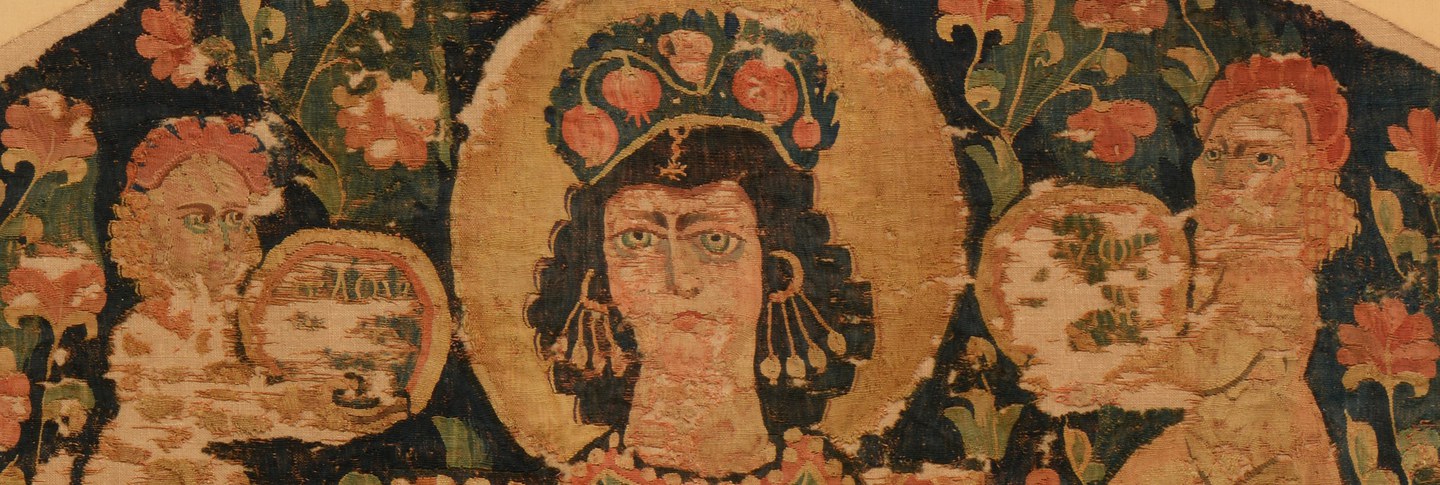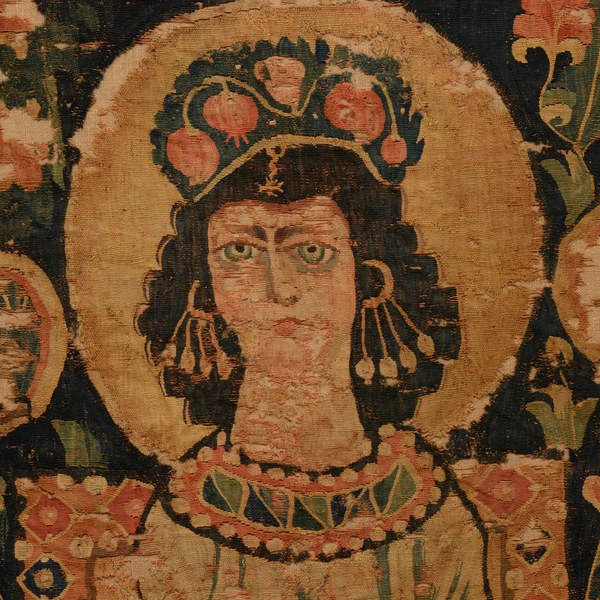
Byzantine Studies Teaching Day
Trade, Treasures, Turmoil, and the End of Late Antiquity
Saturday, February 24, 2024
9:00 a.m. to 4:00 p.m.
Dumbarton Oaks
In conjunction with the special exhibition Rich in Blessings: Women, Wealth, and the Late Antique Household the 2024 Teaching Day will focus on wealth, luxury, and transition in the Late Antique Mediterranean. We will discuss the fruits, both intended and unintended, of the movement of goods, luxuries, and people along the routes connecting the Mediterranean to the Red Sea and Indian Ocean, the elites’ lavish displays of their status and reactions against the inequalities they embodied, before exploring the beginning of the end of the Late Antique world. Students will take part in tours of the exhibition, Museum galleries, and object storage, and attend papers.
Speakers
- Michelle Al Ferzly (Metropolitan Museum of Art), “A Gateway to Paradise: Africa, Byzantium, and the Early Islamic World at the Met.”
- Gregor Kalas (Dumbarton Oaks and University of Tennessee, Knoxville), “Sticking it to the Rich in Late Antiquity: Riots and Urban Unrest."
- Cosimo Paravano (Dumbarton Oaks and University of Vienna), “Were Greek myths just for the rich? Ordinary Christians and pagan myth in Late Antiquity.”
- Michael McCormick (Harvard University), “From Rome to Byzantium with the Science of the Human Past.”
This event is open to students from D.C.-area universities, and registration is now open.

Past Topics
2023
Friend, Foe, or Something in Between
Saturday, March 4, 2023
9:00 AM to 4:00 PM
Dumbarton Oaks
The 2023 Dumbarton Oaks Teaching Day, "Friend, Foe, or Something in Between: Byzantium and Egypt," focused on late antique and medieval Egypt, its people, and its ever-changing relationship with Byzantium. Participants spent the morning exploring the Dumbarton Oaks Museum collections, touring the galleries, and spending time with curators in object storage examining artifacts from Egypt’s Roman, Byzantine, and early Islamic periods. In the afternoon, there were papers exploring Egypt as a Roman/Byzantine province, the survival of Christian communities under the caliphates, Byzantium’s antagonistic relationship with Egypt in Syria, and the processes behind creating an exhibition of Egyptian history..
2022
From Syria to Xi'an: Syriac Along the Silk Road
February 26, 2022
11:00 AM to 02:30 PM
Zoom
The 2022 Dumbarton Oaks Teaching Day, focused on the development of Syriac culture in its spread from the Mediterranean through Mesopotamia and Persia along the trading route through Mongolia to China. Largely a Christian culture, they coexisted beside Jewish, Greco-Roman, Persian, Arab, Seljuk, and Ottoman cultures, reaching East Asia by the ninth century. The speakers will consider various aspects—language, literature, religious practices, and material remains— of these cultures which persist in parts of the Eastern Mediterranean world and in India. Participants were introduced to related artifacts in virtual tours of our museum galleries, along with a newly opened exhibition of Byzantine lead seals.
2021
Whose Byzantium? Identity, Ownership, and Legacy
February 27, 2021
11:00 AM to 02:00 PM
Zoom
The 2021 Teaching Day explored the themes of Byzantine identity as defined by those living inside the empire, how this changed for groups living on the other side of the frontier, and modern “ownership” of Byzantium, its heritage, and its legacy.
2020
Imagining the Afterlife in Byzantium
March 28, 2020
CANCELED
Out of an abundance of caution in response to the COVID-19 outbreak, Dumbarton Oaks canceled all public events. The 2020 Teaching Day would have focused on the ways in which the Byzantines presented and constructed a view of the afterlife in art and the written word. The speakers considered how written historical sources, poetry, icons, and other media were used to imagine angels and demons, and life, or torment, everlasting.
2019
Gift-Giving and Donation in the Medieval World
February 9, 2019
09:00 AM to 04:00 PM
The Oak Room, Fellowship House
The 2019 Teaching Day focused on gift-giving and interaction in Byzantium and Medieval Europe through a combination of papers, object handling sessions, and a tour of the exhibition Juggling the Middle Ages. Participants took part in an exploration of gift-giving and interaction in the context of festivals and holidays, donations and tribute, diplomatic exchanges and religious devotion, and even disease as an unintended consequence of such contacts.
2018
The Outsider in Byzantium
February 17, 2018
09:15 AM to 04:00 PM
The Oak Room, Fellowship House
The 2018 Teaching Day focused on the individual, religious, cultural, artistic, and political outsider in Byzantium. Through a combination of papers and object-handling sessions, participants were introduced to questions about what constituted an outsider and if—or how—a person, object, or idea might transition into something outside the accepted norms of the empire.
2017
At the Center of Empire
February 25, 2017
09:15 AM to 03:30 PM
The Oak Room, Fellowship House
The 2017 Teaching Fellows’ Day focused on Constantinople, the capital city of Byzantium, and its place at the heart of the artistic, ceremonial, political, and ideological life of the empire. The speakers considered how different categories of evidence—textual, visual, and material—offer multiple entry points into our understanding of Constantinople’s place at the center of empire.
2016
Discovering Byzantine Lives: Evidence in Texts, Images, and Material Culture
February 20, 2016
09:15 AM to 03:30 PM
The Oak Room, Fellowship House
The 2016 Teaching Fellows’ Day, “Discovering Byzantine Lives: Evidence in Texts, Images, and Material Culture,” focused on how individuals presented themselves, were perceived by those around them, and were portrayed by others, and what this can tell us about the Byzantines themselves, and how they interacted with each other. In addition, we will consider how different categories of evidence—textual, visual, and material—offer multiple entry points into our understanding of Byzantine lived realities.
2015
Byzantium's Eastern Frontier
February 28, 2015
This year we held our fifth annual Teaching Fellows' Day on Saturday, February 28th. Because the event was held in a larger room in the new Fellowship Building (1700 Wisconsin Ave NW), we were able to offer more seats to local undergraduate and graduate students. A catered lunch was provided, as well as coffee in the morning and afternoon, and there were short guided tours of the museum and the coins/seals collection.
Scott Johnson opened with a talk on the political and linguistic ambiguities along Byzantium's border. Our newest Teaching Fellow, Betsy Williams, followed with a lecture on silk and its imitations at the edge of the empire replete with many vibrant photographs to illustrate her points. After lunch, Jonathan Shea guided the group through the coins and seals collection and gave a talk on the museum's seals. Next, Lain Wilson discussed the importance of easterners--specifically Armenians--to the functioning of the empire. Finally, Eric McGeer closed with a lecture about Nikephoros Ouranos, ruler of the east during Basil II's reign.
Photos
2014
Center and Periphery: Byzantine Capitals outside Byzantium
March 29, 2014
This spring’s Teaching Fellows’ Day attempted to complement the recent exhibition at the National Gallery of Art, “Heaven and Earth: Art of Byzantium from Greek Collections”. Rather than doing a Day conference on Byzantine Greece per se, we focused on political, religious, and intellectual centers of Byzantine Culture—including Byzantine Greece as one of these—outside of the imperial center of Constantinople. This further complemented the courses we are offering at Georgetown and George Washington. At Georgetown, Dr. Scott Johnson is teaching a course entitled “Procopius and Justinian,” which considers the historiographical basis for understanding Justinian’s imperial activities, including the embellishment of imperial capitals throughout the Mediterranean. At George Washington, Dr. Jonathan Shea is teaching “Polis, Civitas, and Madina: Cities in the Medieval Mediterranean,” a course focused on urban developments and urban society in the Byzantine and Islamic world.
Photos
Jonathan Shea Giving His Lecture
Margaret Mullett Delivering Her Talk on Ochrid
2013
Render unto Caesar
April 13, 2013
This year’s event focused on two of the collections at Dumbarton Oaks, the seals collection and the coin collection, both of which are largest in the world. The goal of the day was to explain coins and seals as objects—what they are and how they were made—and to demonstrate how they can contribute to our understanding of Byzantine civilization through the study of art history, prosopography, settlement and archaeology, and literature.
Photos
2012
Pagans, Christians and Muslims: Mediterranean Transitions in the Early Medieval World
March 31, 2012
10:00 am-4:00pm
Founders’ Room, Dumbarton Oaks
The theme this year, ‘Transitions,’ was inspired by two significant exhibitions being held in New York in 2012: the ‘Transition to Christianity’ show at the Onassis Cultural Center and the ‘Transitions’ show at the Metropolitan Museum of Art. The focus was on various transitions which took place in the Byzantine world in the Late Antique and medieval periods: the transition between paganism and Christianity; the transition between Christianity and Islam; and the transition between the ancient and medieval worlds. Students from CUA, GW, and Georgetown were in attendance, and the goal was to give them a sense of Byzantium’s place and role in the context of these larger, world-historical cultural shifts.
2011
Cross Talk
March 26, 2011
On Saturday, March 26, 2011, the Byzantine Studies program at Dumbarton Oaks hosted a day school event entitled ‘Cross Talks.’ The event was held in conjunction with the opening of the ‘Cross References’ exhibition at the Dumbarton Oaks Museum and its aim was to expose local college students to research by leading scholars in various fields of Byzantine studies and also allow them an intimate, first-hand experience of the new exhibition on the Cross. The students were drawn from the classes of Dumbarton Oak’s two post-doctoral teaching fellows: Örgü Dalgiç at Catholic University and Jack Tannous at George Washington University. In addition to students from these two institutions, also in attendance were members of the Dumbarton Oaks Byzantine community; a private art collector from London who lent several objects to the ‘Cross References’ exhibition also was present at the talks.